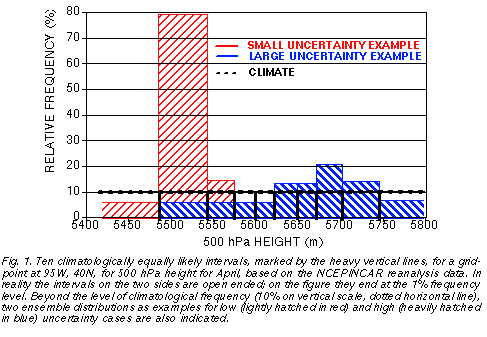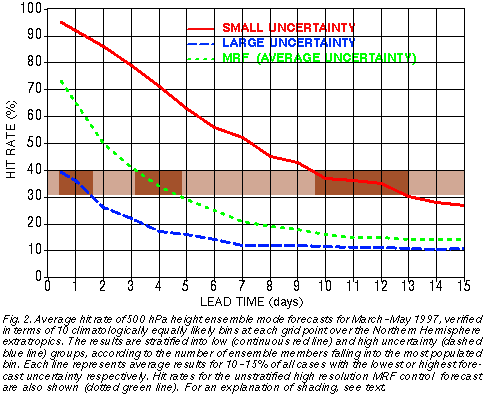
The colors on these figures measure the relative predictability associated
with ensemble mean forecasts (contours) on a scale from 0 to 100. Relative
predictability is measured by the number of ensemble members falling into
the same, climatologically equally (10%) likely bin in which the ensemble
mean falls. Quantitatively, dark blue (red) areas are associated with 10%
of all cases exhibiting the lowest (highest) level of predictability at
any lead time (Fig. 1), while intermediate colors mark areas with predictability
values in between.
Verification studies indicate that the more ensemble members predict an event, the more likely that event verifies. Forecast probability values, marked by the same colors, are based on past verification statistics, reflecting the relative frequency at which the verifying analysis falls into a climate bin with a given number of ensemble members. The probability values reflect temporal/spatial variations in the degree of predictability arising due to initial value uncertainty in a chaotic system, and also account for the effect of using an imperfect model. While probability values, due to the overall loss of predictability, tend to approach the asymptotic value of 10% climate probability with increasing lead time, the range of relative predictability valules is kept unchanged by design.
The red and blue curves on Fig. 2 summarize verification statistics
corresponding to the most and least predictable 10-15% of all cases, marked
as red and blue areas respectively on the relative measure of predictability
charts. Note that at
longer lead times the low- and medium predictability cases show similar
probability values. The relative measure of predictability charts can help
users take advantage of the ensemble's most important benefit, its ability
to objectively identify cases when the forecasts are either below or above
the average level of predictability (marked by a green curve on Fig. 2).
Note that at
longer lead times the low- and medium predictability cases show similar
probability values. The relative measure of predictability charts can help
users take advantage of the ensemble's most important benefit, its ability
to objectively identify cases when the forecasts are either below or above
the average level of predictability (marked by a green curve on Fig. 2).
For further information, please consult the Reference and Training sections of the EMC global ensemble home page.